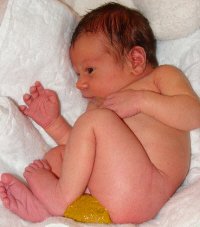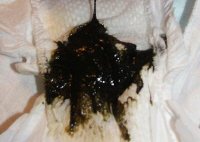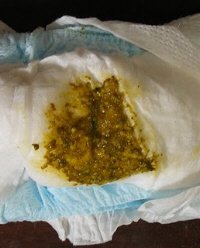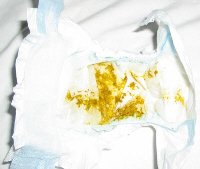 Baby poop is one thing you probably never thought much about before becoming a parent. How much? How often? What color and consistency? These are all important questions about baby excrement that loving and caring parents wonder about. Baby poop is one thing you probably never thought much about before becoming a parent. How much? How often? What color and consistency? These are all important questions about baby excrement that loving and caring parents wonder about.Possibly the most common baby poop worries is baby constipation – which I’ve devoted an entire section to and you can read more about here . Breastfeeding is an art that is slowly perfected over time. In the beginning many mothers worry about their own baby’s infant weight gain and milk intake When your baby is latched on well and you are breastfeeding according to your baby’s hunger cues, infant weight gain progresses naturally. One of the first signs that your baby is eating well and getting enough breast milk can be found in your baby’s diaper. Poop and urine output.
Meconium

Newborn babies pass a rainbow of varying stools in their first days of life. Meconium is the earliest type and it’s viscous and sticky like tar, and has no odor. It should be completely passed by the end of the first few days of baby’s life, with the stools gradually getting more and more yellow. Frequent breastfeeding helps babies pass out the meconium stools as colostrum has a laxative effect. Meconium baby poop can be quite messy and while it has no odor, it can stick to your baby's skin. Applying a coat of petroleum jelly (Vaseline) to your baby's clean dry skin can help make it easier to clean off meconium at the next diaper change.
Baby Urine
In the first two or three days of life, it is considered normal for a newborn baby to only wet one or two diapers per day. As your milk increases, baby's urine output will increase markedly. Your baby is born with extra fluid in his tissues, which is excreted during the first 48 hours after birth. By the fourth day after birth, a baby who is getting enough milk will have 4 to 6 wet disposable diapers a day or 6 to 8 wet cloth diapers(cloth diapers hold less). As your baby grows and takes in more milk, your baby's wet diapers will be even wetter. Read more about what baby pee can tell you. You can tell your baby is getting enough milk by urine output and urine color. A baby who is well hydrated should have pale or water-colored urine. If the urine is darker, apple-juice-colored by day 5 your baby might not be getting enough milk. Brick dust residue might be seen in your baby's diaper if she isn't getting enough milk. This unusual residue in the diaper is actually normal in the first few days of life but suggests dehydration in older babies. It is caused by urate crystals.
Transitional Baby Stools

When your baby has passed the meconium stage there will be a period of changing stools which are greenish-brownish in color. It is normal for newborn babies to pass poop that looks full of watery substance and mucus. If you are worried, take a soiled diaper to your pediatrician so that she can make sure everything is normal.
Settled Baby Poop

Frequent and regular feeding will help your baby pass stools that are soft, yellow and seedy. It may take 3 weeks or more for your baby to settle into passing regular yellow seedy milk stools. Exclusively breastfed babies usually pass very soft yellow to orange-ish colored stools that look a lot like mustard. Normal breastfed baby poop only has a mild odor. Occasionally your baby may also pass stools that are greenish, mucusy and or lumpy looking. It’s best not to pay too much attention to what the poop looks like as long as your baby is healthy. It’s best to pay attention to your baby’s her general well being. Different babies have different poop patterns. While your baby might pass stools after every feed and fill up an entire diaper pail with soiled diapers in one day, it is completely normal for another baby to have a stool motion every 3 or 4 days. There may be times where your baby only poops once in a week. It is perfectly healthy and normal for a baby who is feeding well to swing between both extremes. Breastmilk is a natural laxative so as long as your baby is producing wet, urine soaked diapers there is usually no need for concern.
Hard Stool and Constipation
Exclusive breastfeeding makes it very unlikely for your baby to get severe diarrhea or become constipated. Babies can go a week without passing stool and even if you notice your baby going red in the face pushing one out it doesn’t necessarily mean constipation. Bottle and formula fed babies can suffer from constipation. Lack of fluids and dehydration in bottle-fed babies are the common causes and need to be addressed by a pediatrician.
Older Babies
Older babies who eat solid foods in addition to breastmilk may pass the occasional hard stool. Hard stools are a sign that your baby is not taking in enough fluids. It is usually easy enough to introduce more breastmilk feedings or water and if hard stools continue try giving some diluted fruit or vegetable juice. With the introduction of solid foods or other liquids, come many changes in baby's elimination patterns. Baby poop will have a stronger odor and different color and consistency. You may start to notice traces and pieces of vegetables in your baby's diaper, which is very common. At this stage, to constipation and even diarrhea might be signs that your baby isn't tolerating a new food or juice.
Baby Poop No-no’s
Do not give your baby any form of laxatives unless you are given a prescription by your baby’s doctor. It is most often a very grave mistake to try to override your baby’s natural bowel system. You should never interfere with your baby poop habits with laxatives or enemas. It can be very harmful and damaging both physically and emotionally for a normal healthy baby. Breastfed Infant Weight Gain Chart| Age of Baby | Healthy Weight Gain pounds ~ grams | | Birth to 7 days | A loss of less than 10% of birth weight | | Day 14 | Has regained birth weight | | 2 to 7 weeks | 20 to 30 grams per day | | Birth to 3 months | 6 oz ~ 170 gm.s per weekor 1.5 - 2 lb.s ~ 680-906 gm.s per month | | 4 to 6 months | 4-5 oz ~ 113-142 gm.s per week | | 6 to 12 months | 2-4 oz ~ 57-113 gm.s per week |
|